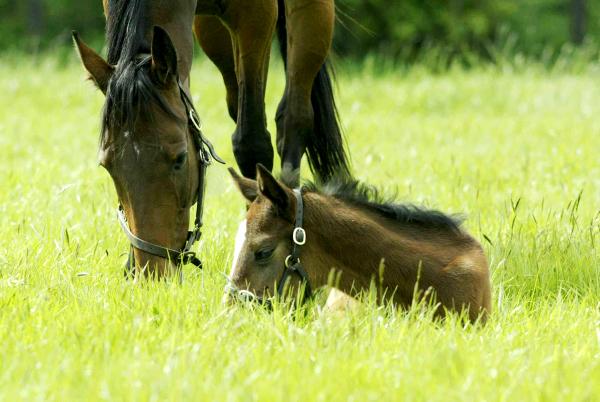Maureen Dowling*, from the school of veterinary medicine at UCD, advises on nutrition for the mare and foal
A sufficient nutritional programme for broodmares throughout pregnancy and lactation will optimise foal growth and performance throughout its life, while also reducing conception intervals and improving your breeding programme. Feed intakes can vary depending on the changing needs of the broodmare and also the stage of gestation.
Body condition
The use of a body condition score (BCS) system allows breeders to use a subjective indication of fat deposition to assess their mare for nutritional purposes. An ideal score of five to seven (moderate) on a nine point scale should be kept throughout gestation and post-partum for broodmares. BCS should be monitored and assessed closely throughout pregnancy and also during lactation.
Gestation
Non lactating/barren mares will have the same nutrient requirement as mature horses at maintenance level and therefore do not require supplementation of nutrients if kept on good quality forage or grazing. Mares with a BCS lower than four will have difficulty with conceiving and may have increased issues maintaining a pregnancy.
A common mistake during early gestation is overfeeding mares, monitoring weight and body condition closely should be done to make sure mares aren’t gaining too much weight.
Drastic changes to diet in the first 90 days of pregnancy should be avoided as this can contribute to embryonic loss and abortion.
Protein and energy requirements will begin to increase from in the fifth month of pregnancy. A diet of good quality hay/grass should be available at a rate of 1 – 1.5% bodyweight; however a forage only diet may lack key vitamins and minerals. A stud balancer pellet or fortified broodmare feed should be introduced at the end of this stage.
From the eighth month of pregnancy, increased foetal growth rates results in significantly higher requirements of protein, energy, vitamins and minerals for the mare.
As always good quality forage should be the basis of the diet, but the introduction of concentrates is vital at this stage. Feeding and supplementation should begin to meet these needs in order to maintain the condition of the mare, while supplying adequate levels of nutrients to the foal.
To support the foal’s growth and ability to absorb essential antibodies through colostrum after foaling, it is advised that mares receive a 13% -15% protein feed.
Lactation
Due to the stress of parturition, milk production and successive breeding, the nutrient requirements of the mare are at their greatest during lactation. The monitoring of BCS is crucial at this stage, as bodyweight can drastically diminish if energy intake becomes negative due to milk production. If negative energy balance is extreme, this can result in poor conception rates and foal growth.
A high-quality, energy-dense feed is recommended at approximately 1kg per 100kg BW per day depending on BCS. If further additional energy is required, a fat source such as flaxseed oil, can provide extra calories during this stage. Peak lactation occurs at approximately eight to twelve weeks after foaling, as milk production decreases so too can concentrate feed.
The rate of feed reduction should be gradual and be based on the condition of the mare prior to weaning.
Foal nutrition
Feeding of foals must be carried out accurately due to anatomical limitations, such as their digestive tracts are not developed enough to ingest low-energy bulky feeds.
They must be gradually fed concentrated sources of proteins, energy, minerals and vitamins to meet their nutritive requirements. Due to the nutrient requirements for foals and weanlings being so high, management of growth must be done properly.
Growing horses will benefit from being fed a diet that promotes moderate rather than fast growth rates. Average foals will consume 15kgs of milk daily; this along with occasional grazing will provide sufficient nutritional requirements during their first three months.
However when a decline in milk production occurs after this period, the foal’s requirements continue to increase and so feeding of concentrates can provide foals with the extra nutrients needed to fill this imbalance.
Feeding rates vary depending on genetics, age and skeletal size of the foal along with the quantity and quality of forage available. It is recommended to introduce concentrate feed to foals at approximately 12 weeks of age.
Using a commercial feed formulated for growing horses will provide the nutrients necessary for optimum growth and development. Growing foals have the highest protein requirement. It is best to choose protein in the concentrate according to the type of forage available; high protein forage requires less protein percentage in the concentrate ration.
Approaching weaning age, nutrition becomes of paramount importance as this is when the skeleton is most vulnerable to developing skeletal problems.
By six months, a foal should be consuming approximately 0.8-1kg per 100kg of BW per day of a complete feed. If pasture is maintaining growth sufficiently, the diet can then be supplemented with a young stock balancer which can provide a low-calorie source of nutrients to prevent any developmental orthopaedic diseases (DOD). The best way to assess if the weanling is consuming adequate amounts of minerals and vitamins is through a ration evaluation or by using a commercially balanced feed.
If the foal is showing signs of excess body weight reduce the energy intake in the diet but not protein levels. Research has shown that exercise helps to regulate muscle growth and therefore allowing young horses ample turnout during this stage of life, reduces DOD significantly.
* Maureen Dowling is an Animal Science-Equine degree graduate from UCD and is currently in the final stage of a PhD based on equine nutrition in the School of Veterinary Medicine, UCD.








SHARING OPTIONS